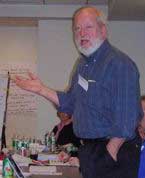[© Copyright. Feel free to link to this blog. Please ask author for permission before copying.]
II. The Challenges
The positive and perhaps overly optimistic portrait of the wise leader which I offered in the previous blog needs to be moderated—for the wise leader is not always so gracious and delighted with the transition of leadership to the next generation.
The Leader’s Ambivalence
The premodern leader can at times be quite resistant to this transition and may be threatened by the acquisition of new knowledge and additional experiences by younger men and women. This threat and resistance is often couched in ambivalence. The wise leader teaches and encourages education, yet doesn’t want the new kid on the block to become too smart or too experienced. I have worked with many young men and women from Asia who come to the United States to obtain a Masters Degree in Management. Their father (and presumably their mother) fully supports them in obtaining this education. They provide the funds to support this advanced education and enable their son or daughter to take time off from their life in Asia in order to study in the United States. Yet, when these young men and women return home, freshly “educated” in the new models of management, finance and marketing, they often bump up against a surprisingly resistant parent. The outcry of frustration is common (though usually softly spoken by my Asian students): “Why did my father [mother] pay for this education if he [she] doesn’t want me to use it!!” I now suggest strategies whereby they “ease in” their suggestions for change and improvement. They look with “appreciation” on the practices of their father or mother that are fully aligned with contemporary management practices.
The Followers’ Ambivalence
Even when the wise leader is fully open to the transition in leadership, there is often a hesitation on the part of other members of the organization to acknowledge, let alone actively support, this transition. They have relied for many years on the wisdom of the “old” leader and do not yet trust the competence of the new leader—he or she is not yet “tested” as to the practicality of their wisdom. Do we dare risk relying on this person’s experience, when we have the wise, old leader to guide us? Ironically, even when the knowledge and expertise of the old leader is now “out-of-date” – which is very common in our technologically-driving, postmodern world—there is still a yearning for that which is known and reliable. The old leader either no longer has an agenda to press on the organization or has an agenda that is widely acknowledged and which other members of the organization can factor in when taking into account the advise or guidance offered by the old leader. Wisdom, in other words, is based not just on the experience and expertise of the wise leader; it also is based on the experience of those who follow this leader: the followers are “wise” about the leader’s “wisdom.”
Succession Planning
The challenge for this form of leadership can thus be summed up in two words” SUCCESSION PLANNING. When a wise leader is playing a key role in an organization, then plans must begin very early regarding the preparation of other men and women to assume the wise old leader’s role. This involves not just the mentoring of the new leader(s) by the old leader, but also the building of formal programs that prepare the organization for this transition in leadership. In some instances, these formal programs involve placing a new person in an interim leadership role (alongside the old leader); in other instances, it means the use of rituals and rites regarding the succession; in yet other instances, it means sending the new leader off for additional training or education. With regard to this third option, I have always been impressed with the policy of many religious orders (particularly orders of Catholic nuns) to send someone who is about to assume a position of leadership to an executive leadership program (at Harvard, Yale or a comparable institution). This provides the new leader with an opportunity not only to step away from their own organization to gain a fresh perspective, but also to return to their home organization with new credibility (like Alexander the Great) and with reassuring breadth and depth of “wisdom.”
We are still, in many ways, living in premodern organizations and living in the back of our minds and hearts in a world that yearns for men and women of wisdom. It is important—perhaps essential—that we recognize this premodern reality and acknowledge this premodern yearning for a certain type of leadership. As I will note in future blogs, we yearn also for other types of leadership and look for other types of leaders in our hybrid world of premodern, modern and postmodern social systems.



 Posted by William Bergquist
Posted by William Bergquist 